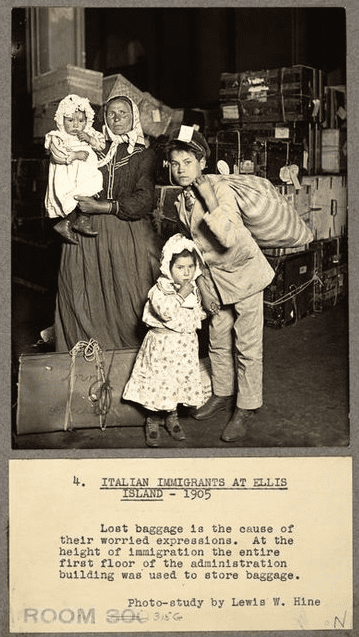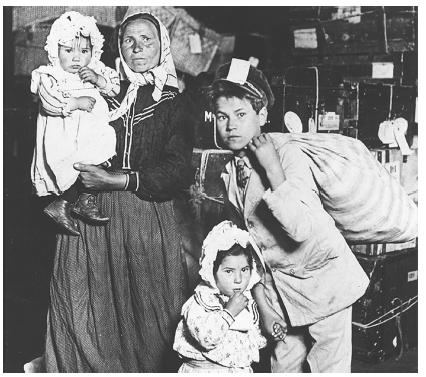
Give me your tired, your poor,
Your huddled masses yearning to breathe free,
The wretched refuse of your teeming shore.
Send these, the homeless, tempest-tost to me,
I lift my lamp beside the golden door!
That’s the story we learn in school, isn’t it?
Immigrants were destitute and persecuted, and would have starved had they stayed in their home countries, but the United States offered them refuge.
What’s more, we’re told, whenever one expresses concerns about assimilation of our current cohort of immigrants, that the native born have always feared lack of assimilation, but each successive cohort of immigrants landed at the bottom, and worked their way up, to be replaced by a new cohort of immigrants at the bottom, a new wave from a new country, now feared and disdained by the very sons-of-immigrants who had forgotten about their roots.
Which is all a very moving story, and suggests that the morally right thing for we Americans who are descendants of immigrants to do, is to continue to allow new waves of immigrants in, with as much generosity as in the past, knowing that history “proves” that our fears are misguided. We should also think back in our family history and know that it’s hypocritical to object to the entry of largely poor and uneducated workers, because our ancestors came under similar circumstances.
Here’s another document, the “official” Catholic “social teaching” on immigration:
First Principle: People have the right to migrate to sustain their lives and the lives of their families. . . .When a person cannot achieve a meaningful life in his or her own land, that person has the right to move. . . .While individuals have the right to move in search of a safe and humane life, no country is bound to accept all those who wish to resettle there. By this principle the Church recognizes that most immigration is ultimately not something to celebrate. Ordinarily, people do not leave the security of their own land and culture just to seek adventure in a new place or merely to enhance their standard of living. Instead, they migrate because they are desperate and the opportunity for a safe and secure life does not exist in their own land. Immigrants and refugees endure many hardships and often long for the homes they left behind. As Americans we should cherish and celebrate the contributions of immigrants and their cultures; however, we should work to make it unnecessary for people to leave their own land.
Now, there’s a sleight of hand in the move from “right to migrate to sustain life” to a right to a “meaningful life,” and from the “right to migrate” as a right to leave one’s home country, into a right to move to the particular country of one’s choice, but, apart from that, the clear expectation is that, by the very fact that they are migrants, all migrants are compelled to leave their home countries because of the utter misery there, so that it’s not even open to discussion whether they “needed” to migrate or not.
But what if that’s not true?
I’ve been reading a book that I dug out of my basement, The Transplanted, A History of Immigrants in Urban America, by John Bodnar. Like most such books in my basement, it dates to my college/grad school days, and, in particular, was published in 1985, so I can’t attest to the degree to which his ideas have held up or been supplanted by new scholarship (and whether that new scholarship is credible or just new). Fun fact: the image above, from the Wikipedia entry on Italians in the United States, is also the cover photo; I find it interesting that this photograph, at least to me, produces a sense that these people are destitute and downcast but the caption says they’ve got more luggage than the few items in the photo, lost in the Ellis Island version of baggage-claim.
Anyway: the first chapters of the book talk about the circumstances in which immigrants came to the United States. There were a number of factors, among them the population growth in any given country, and the inheritance patterns — whether the farm is divided among all children/sons, or passed on to the firstborn — but also the impact of the industrial revolution and capitalism (in the sense that historians use the term, to talk about the advent of factories owned by capitalists — men with capital — replacing small family workshops) and large-scale “capitalist” agriculture; all of these, as well as specific political events (e.g., the impact of the unification of Italy) impacted different parts of Europe at different times. In addition, the simple factor of transportation — the ease with which some regions could access ports — played a role, and there was a common pattern of migration from one region of the country to another preceding emigration elsewhere.
But here’s the key pattern Bodnar observes: it was not the wealthy who immigrated — they were doing just fine where they were. It was not the poor, either — they couldn’t afford to travel, and were more likely to end up in the industrializing cities (or, for the Irish, to cross the Irish Sea to England); it was the middle- and lower-middle class.
Abundant evidence exists . . . to suggest that those departing were not coming from the depths of their respective society but occupied positions somewhere in the middle and lower-middle levels of their social structures. Those too poor could seldom afford to go, and the wealthiest usually had too much of a stake in the homelands to depart. (p. 13)
(Commenter SKJAM! mentioned this just yesterday, coincidentally, in a comment on my “Fact-checking the fact-checkers” post, which spurred me to take this post out of its half-written draft form.)
To be sure, that wasn’t universally true, and certain groups had more “push” than “pull” factors (yes, I know about the Irish during the potato famine!) but Bodnar supports this conclusion with details from a number of immigrant groups. Here’s a bit about the Italians:
The image of poor peasants fleeing to America has also dominated much of the scholarship on Italian emigrants but closer analysis reveals that the very poor seldom left. For instance, the average yearly wages in Abruzzi e Molise and Calabria were well above those in Tuscany and Lombardy, and yet emigration was heavier from the former provinces than the latter. Usually those who left were in the middle and lower-middle levels of the peasantry. Supplementing this stream was a characteristic segment of artisans, craftsmen, and others with skills which were increasingly difficult to implement in societies undergoing either a commercialization in agriculture or growing competition with manufactured goods. (p. 20)
It is also a key part of the “immigrant” experience that a fair number of these arrivals were not immigrants at all, but simply migrants. Here’s Bodnar again:
No phenomenon is more central to understanding the motives of those moving from agricultural to industrial regions nor more revealing about the predisposition to use industrial wages to improve or maintain status in the rural world than the process of return migration. Because everyone did not or was unable to return should not obscure the fact that a return was usually every emigrant’s goal. The only major exceptions seem to have been those who had worked as craftsmen or those who ventured to America before 1860 with sufficient capital to initiate farming or commercial enterprises in the new world and groups such as East European Jews who faced severe political restrictions in the homeland. While estimates vary, return rates usually ranged from 25 to 60 percent, although most records on immigration are somewhat imprecise. Hvidt found about 30 percent of the Danes returning, and the German figure was between 35 and 40 percent. About four of every ten Greeks returned, and the Polish figure was only slightly below that. The most likely of all to return were those from central and southern Italy (56 percent) and northeast Hungary. Magyar rates have been estimated at 64 percent and those of Slovaks at 59 percent. (p. 53)
And, indeed, Lazarus wrote her poem with an eye to the plight specifically of Jews escaping persecution in Russia, not with respect to immigrants in general.
It’s my understanding that, in many cases, the same is true today. The Syrians and other migrants who flooded into Europe via Turkey over the past several years paid a substantial amount of money for the trip — as much as $10,000. There are reports of Africans making there way across the Atlantic into Central America, and then upwards to Mexico and then crossing illegally into the U.S. — again, not a cheap voyage.
Now, I’ll admit that I’m not far enough along in my reading of this book or others to assess the second half of the “immigration myth,” that each successive cohort of immigrants worked their way up, only to wrongly disdain the new arrivals. I had hoped to do some reading and come to a firmer conclusion on that point before writing this up, but I’m running out of steam. But it doesn’t seem to fit with with what I know about American economic mobility, at least in its most simplified form. If you think about the urban poor in the 19th century, was it really the case that the children of immigrant factory workers went to school, learned their lessons, and got good office jobs when they graduated? Wasn’t it, by and large, the case that those children left school in their early teens (or even earlier) and went to work in those same factories, and only with the advent of the modernization of the economy in the 20th century, that the lot of the urban poor improved, for everyone regardless of how many generations ago their ancestors immigrated? To be sure, there was a certain social and political mobility, as Irish-ancestry politicians came to dominate machine politics, for example, but that’s not the same thing as this simplified view of income stratification by time-since-arrival.
What does this mean? Largely, it’s a matter of what this doesn’t mean. The narrative of “we have an obligation to welcome destitute immigrants because our ancestors were also once destitute” doesn’t work, nor does “all migrants are always, by definition, only ever coming because they are in dire need.” I am not, in this post, expounding on the right decisions about immigration to the United States in the year 2017. I’m just saying that we can’t make them by telling ourselves incorrect stories about the past.
UPDATE: yes, there are issues with line spacing. Bear with me.
And here’s a related article, “Syrian Refugees Resettled in the U.S.: Why Them and Not Others?” which says that the UNHCR seems to be picking refugees for resettlement to the US seemingly at random, even among people who had a fairly stable living situation, despite the claim that they were sending the most vulnerable, the most needy. Not sure what to make of this but it seemed worth sharing.
Image: By Lewis W. Hine(Life time: 1874-1940) – Original publication: Photo-studyImmediate source: Brooklyn Museum, Public Domain, https://commons.wikimedia.org/w/index.php?curid=51292180













